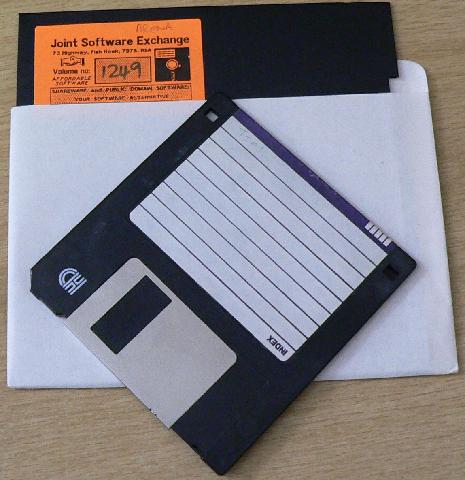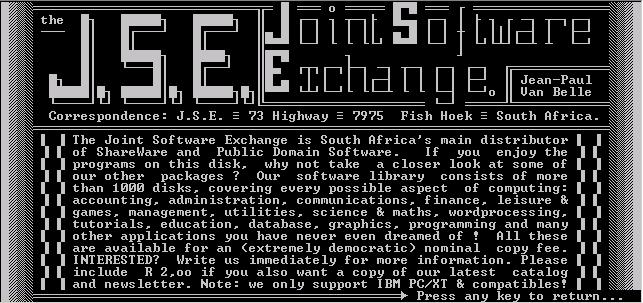Sometimes I manage to impress myself bigtime.
A while ago, I left a comment on Jimmy’s page on Robot War, about Arena, which is basically* Robot War for the PC. This morning I received an email from Core War fundi John Metcalf, saying that he’s never heard of Arena, and would like to know more.
So I thought about it for about half a cup of coffee, remembered which box it was most likely to be, retrieved the box from behind the Puma, and the disk I was looking for was about the tenth disk down (this was the lucky bit — there are about 200 disks in there I guess).
The key point here is that I last used these disks on my father’s PC (the one before the one before the one he has now — it was a 386 on one of those motherboards that still took a 287 coprocessor) back in the early nineties. Call it twenty years plus tax.
The fact that I can’t find a notebook battery that I had in my hand day before yesterday is not relevant to the story.
So then I had to fire up the third machine on my desktop**, click the KVM over, and copy the files to something my main machine can read.
Now I know for a fact that the vast majority of my readers (both of them) are suffering MEGO with a side of TMI. So here’s a cut line for you. It gets geeky on the other side.
* Bad pun. Should be assemblerly. You don’t get it. Don’t worry. I’ll explain it.
** Primary machine is a Windoze 2K box. #2 is my Linux box, and #3 is a 486 (or maybe an early Pentium) which mostly boots DOS (with Windows 3.1 if I really need to do that) and runs my Expro.
(no, those were footnotes. And only a bit geeky. Here’s the cutline)
The Joint Software Exchange
Back in the late eighties, Jean-Paul van Belle ran the Joint Software Exchange out of Fish Hoek. He had a fairly large collection (as you can see, Arena was #1249 in his catalogue) of shareware disks which he copied to floppies (yours, or supplied by him) for a nominal fee. The Simtel / CICA / Walnut Creek CDROMs pretty much put an end to this era. But at the time I got maybe thirty or so disks from him. Good old 360k floppies.
So, on to the topic at hand. Arena.
Volume in drive B is JSE # 1249
Directory of B:\
AEDIT COM 21,383 02-05-86 1:23p
AEDIT DOC 4,240 08-24-85 8:02p
ALIST COM 14,499 02-05-86 1:41p
ALIST DOC 1,069 08-24-85 8:04p
AREAD ME! 343 08-21-85 6:53p
ARENA DOC 21,343 10-27-85 9:08p
ARENA PRO 3,238 10-27-85 9:12p
CARENA COM 35,043 02-05-86 1:53p
COLOR BAT 479 08-21-85 6:42p
ERRATA TXT 803 11-13-85 4:46p
MARENA COM 35,004 02-05-86 1:48p
MOLE LST 119 10-27-85 8:47p
MONO BAT 466 08-21-85 6:43p
PEEKER LST 335 10-27-85 8:47p
RADAR LST 385 10-27-85 8:47p
TARGET LST 190 10-27-85 8:48p
JSE COM 2,015 02-29-88 12:00a
BROWSE COM 958 01-02-86 3:54a
JSE TXT 1,924 02-29-88 12:00a
JSDISK HLP 4,701 01-14-88 2:15p
ARENA V 2.1 0 12-22-87 12:21a
21 file(s) 148,537 bytes
202,752 bytes free
If you want to download this, look here.
From ARENA.DOC
HISTORY
Arena is a simultion [sic] of gladiatorial combat in the future, where the
combatants are robots programmed by their “Controllers.” Fighting up to
six to a side, the winning robots are those who still stand after the
smoke clears. Robots are given intelligence, weapons, and armor to have a
fighting chance of survival. Your position, luckily for you, is of one of
the controllers. You are given a factory where you can build up to six
robots, program them, and send them to the arena to fight the creations of
your opponent.
So far, so good. Sounds like Robot War. However
INTRODUCTION
ARENA is written to be both an enjoyable game and an introduction into
the world of assembly language. The language is based on Intel’s
Mnemonics, and thus is ideal for learning Z80, 808x, and 80×86. It is not
a complete set (missing are stack operations, interrupts, logical
operators, and other processor specific commands). Version 3 will be
geared after the 8088/8086 processor, to help all those with IBM PCs and
compatibles. This program is designed to run on the above machine, and
any machine that uses MS-DOS. It was written on a Leading Edge FXD, and
should run on IBM, COMPAQ, Sanyo, Corona, etc.
Where the Robot War language is BASIC-like, Arena is based on Intel assembler. Jimmy says that “The [Robot War] programming language you work with is extremely primitive even by the standard of BASIC, with just a bare few commands” — well, here’s RADAR from Arena :
RADAR.CYB Brain: 3 Cannon: 3 Hull (Armor): 4 1: GUN :G 2: RAD :G 5 ;scan 3: CMP :S -1 ;enemy? 4: JEQ 6 5: JMP 1 6: MOV :T 7: GUN :T 8: SUB :T 1 9: GUN :T 10: ADD :T 2 11: GUN :T 12: SUB :T 2 13: GUN :T 14: END
And this is pretty much where I gave up playing with Arena. x86 assembler is a necessary evil, I had to commit some as part of my lectures, but I’m an assembler geek of the 6809 / 68000 school and that’s not going to change.



Hi, thanks for posting this. I haven’t been able to find any other info online, e.g. when the first version was published, if there’s a newer version, how many issues of The Electric Gladiator were sent out.
I’ve just entered the sample bots using the Arena editor and run my first battle :-)